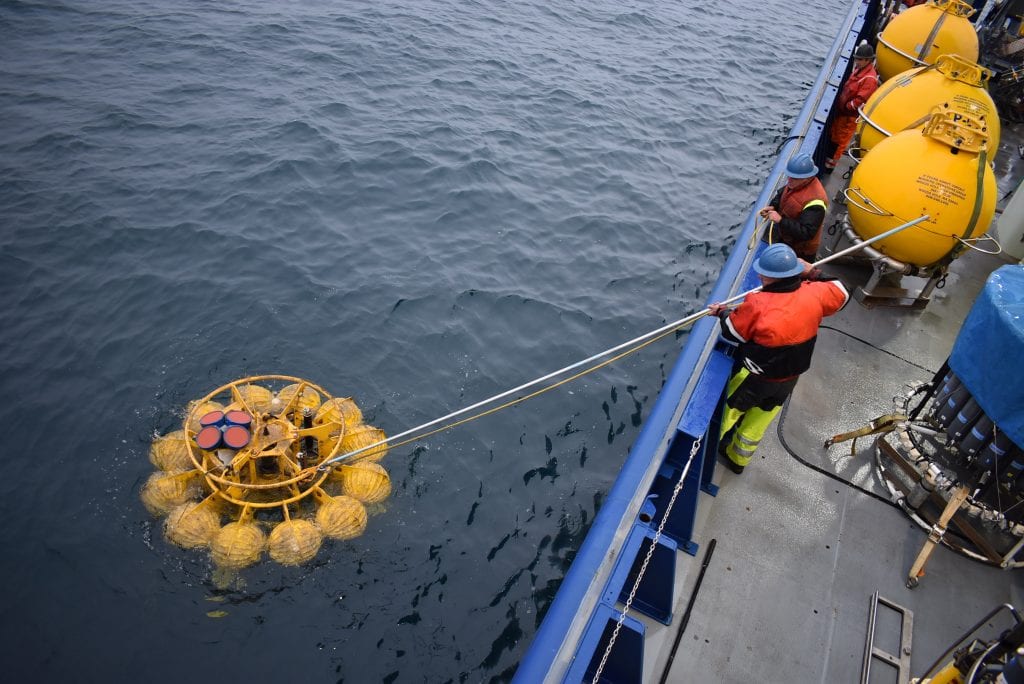Changes in the North Atlantic deep western boundary currents not directly linked to the Meridional Overturning Circulation in 2014-2018

Jim Dunn, John Kemp and Andy Davies recover an OSNAP shelf mooring aboard the R/V Neil Armstrong in summer 2020. Photo credit: Isabela Le Bras, copyright WHOI
A new study through the international efforts of fifteen research institutes has cast doubts on the view that variations in the density of some of the deepest currents of the subpolar North Atlantic ocean are caused by winter surface conditions and represent changes in the strength of the Meridional Overturning Circulation (MOC).
Led by Dr Feili Li and Professor Susan Lozier from Georgia Institute of Technology, in partnership with Professor Penny Holliday, from the National Oceanography Centre (NOC), the research published in May 2021 in Nature Communications shows that observations made over 4 years from 2014 in the subpolar North Atlantic reveal no imprint of strong winter cooling at the surface of the ocean on the density of the deepest boundary currents found in the western regions of ocean basins. Surprisingly, the authors also found no discernible relationship between changes in those deep western boundary currents and variations in the strength of the MOC.
Knowledge of the physical processes that govern changes in the MOC are essential for accurate climate projections. The MOC brings vast amounts of heat and salt into the northern Atlantic via the Gulf Stream and North Atlantic Current. Changes in the strength of the MOC directly affect sea level, climate and weather for Europe, North America, and parts of the African continent. Climate projections all predict a slowing of the MOC as a result of greenhouse gas emissions, with potentially damaging impact on coastal communities and land.
Previous analysis of models has led scientists to think that changes in the strength of the MOC are associated with changes in the density of the deep western boundary currents which make up most of the southward return flow of the MOC loop. In models their density can be strongly affected by a winter process called deep convection or deep water formation, where cold winds cool the surface water causing it to become very dense and sink to great depths (more than 2km). The relationship in models between convection, changes in deep western boundary currents and the strength of the MOC also underpins evidence from paleoclimate proxies for periods of reduced MOC and low European temperatures.
In 2014 a huge array of scientific instruments was placed in the subpolar North Atlantic (OSNAP) to observe these processes in real life. The surprising new results will stimulate a reconsideration of the notion that deep western boundary changes represent overturning characteristics, with implications for future climate projections as well as the interpretation of past climate change.
Prof. Susan Lozier, overall lead of the international OSNAP programme, said “It is gratifying to see what an international community of oceanographers can achieve with a concentrated effort of collaboration and determination. Programs such as OSNAP and RAPID are blueprints for how oceanographers across the globe can collectively study the ocean’s role in climate change in the years and decades ahead.”
Several scientists from the WHOI Physical Oceanography (PO) Department were also involved in the research and are co-authors on the study, including Dr Amy Bower (PO Senior Scientist and Department Chair), Dr Isabela Le Bras (PO Assistant Scientist), Astrid Pacini (MIT-WHOI Joint Program graduate student in PO), and Dr Robert Pickart (PO Senior Scientist).
Pacini was part of three OSNAP cruises so far and said: “This study highlights the importance of looking beyond density changes in deep western boundary currents as a way to predict the MOC. The results underscore the importance of integrating the complex processes and pathways involved in the overturning circulation. Having sailed on three of the OSNAP cruises (one during the pandemic), it is exciting to see the power of collaboration and the importance of combining and synthesizing regional expertise to understand basin-wide circulation.”
Funding for this research was provided by the National Science Foundation.
